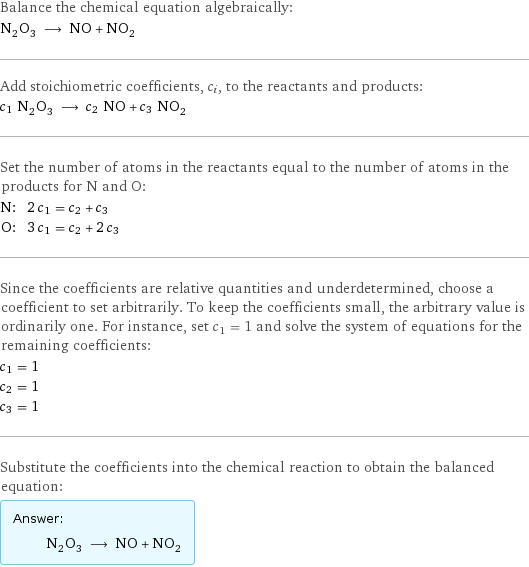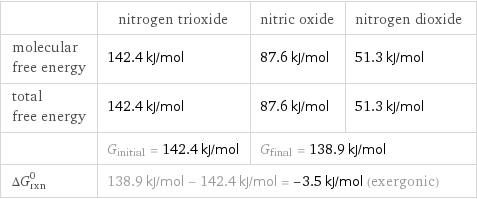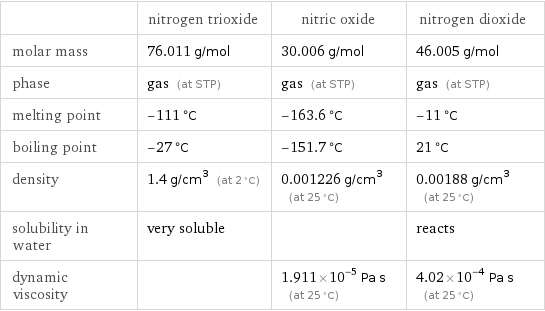Input interpretation

N_2O_3 nitrogen trioxide ⟶ NO nitric oxide + NO_2 nitrogen dioxide
Balanced equation

Balance the chemical equation algebraically: N_2O_3 ⟶ NO + NO_2 Add stoichiometric coefficients, c_i, to the reactants and products: c_1 N_2O_3 ⟶ c_2 NO + c_3 NO_2 Set the number of atoms in the reactants equal to the number of atoms in the products for N and O: N: | 2 c_1 = c_2 + c_3 O: | 3 c_1 = c_2 + 2 c_3 Since the coefficients are relative quantities and underdetermined, choose a coefficient to set arbitrarily. To keep the coefficients small, the arbitrary value is ordinarily one. For instance, set c_1 = 1 and solve the system of equations for the remaining coefficients: c_1 = 1 c_2 = 1 c_3 = 1 Substitute the coefficients into the chemical reaction to obtain the balanced equation: Answer: | | N_2O_3 ⟶ NO + NO_2
Structures

⟶ +
Names

nitrogen trioxide ⟶ nitric oxide + nitrogen dioxide
Reaction thermodynamics
Enthalpy

| nitrogen trioxide | nitric oxide | nitrogen dioxide molecular enthalpy | 86.6 kJ/mol | 91.3 kJ/mol | 33.2 kJ/mol total enthalpy | 86.6 kJ/mol | 91.3 kJ/mol | 33.2 kJ/mol | H_initial = 86.6 kJ/mol | H_final = 124.5 kJ/mol | ΔH_rxn^0 | 124.5 kJ/mol - 86.6 kJ/mol = 37.9 kJ/mol (endothermic) | |
Gibbs free energy

| nitrogen trioxide | nitric oxide | nitrogen dioxide molecular free energy | 142.4 kJ/mol | 87.6 kJ/mol | 51.3 kJ/mol total free energy | 142.4 kJ/mol | 87.6 kJ/mol | 51.3 kJ/mol | G_initial = 142.4 kJ/mol | G_final = 138.9 kJ/mol | ΔG_rxn^0 | 138.9 kJ/mol - 142.4 kJ/mol = -3.5 kJ/mol (exergonic) | |
Equilibrium constant
![Construct the equilibrium constant, K, expression for: N_2O_3 ⟶ NO + NO_2 Plan: • Balance the chemical equation. • Determine the stoichiometric numbers. • Assemble the activity expression for each chemical species. • Use the activity expressions to build the equilibrium constant expression. Write the balanced chemical equation: N_2O_3 ⟶ NO + NO_2 Assign stoichiometric numbers, ν_i, using the stoichiometric coefficients, c_i, from the balanced chemical equation in the following manner: ν_i = -c_i for reactants and ν_i = c_i for products: chemical species | c_i | ν_i N_2O_3 | 1 | -1 NO | 1 | 1 NO_2 | 1 | 1 Assemble the activity expressions accounting for the state of matter and ν_i: chemical species | c_i | ν_i | activity expression N_2O_3 | 1 | -1 | ([N2O3])^(-1) NO | 1 | 1 | [NO] NO_2 | 1 | 1 | [NO2] The equilibrium constant symbol in the concentration basis is: K_c Mulitply the activity expressions to arrive at the K_c expression: Answer: | | K_c = ([N2O3])^(-1) [NO] [NO2] = ([NO] [NO2])/([N2O3])](../image_source/dbb7f6b16917c9aa8396d57c8a3cc6ca.png)
Construct the equilibrium constant, K, expression for: N_2O_3 ⟶ NO + NO_2 Plan: • Balance the chemical equation. • Determine the stoichiometric numbers. • Assemble the activity expression for each chemical species. • Use the activity expressions to build the equilibrium constant expression. Write the balanced chemical equation: N_2O_3 ⟶ NO + NO_2 Assign stoichiometric numbers, ν_i, using the stoichiometric coefficients, c_i, from the balanced chemical equation in the following manner: ν_i = -c_i for reactants and ν_i = c_i for products: chemical species | c_i | ν_i N_2O_3 | 1 | -1 NO | 1 | 1 NO_2 | 1 | 1 Assemble the activity expressions accounting for the state of matter and ν_i: chemical species | c_i | ν_i | activity expression N_2O_3 | 1 | -1 | ([N2O3])^(-1) NO | 1 | 1 | [NO] NO_2 | 1 | 1 | [NO2] The equilibrium constant symbol in the concentration basis is: K_c Mulitply the activity expressions to arrive at the K_c expression: Answer: | | K_c = ([N2O3])^(-1) [NO] [NO2] = ([NO] [NO2])/([N2O3])
Rate of reaction
![Construct the rate of reaction expression for: N_2O_3 ⟶ NO + NO_2 Plan: • Balance the chemical equation. • Determine the stoichiometric numbers. • Assemble the rate term for each chemical species. • Write the rate of reaction expression. Write the balanced chemical equation: N_2O_3 ⟶ NO + NO_2 Assign stoichiometric numbers, ν_i, using the stoichiometric coefficients, c_i, from the balanced chemical equation in the following manner: ν_i = -c_i for reactants and ν_i = c_i for products: chemical species | c_i | ν_i N_2O_3 | 1 | -1 NO | 1 | 1 NO_2 | 1 | 1 The rate term for each chemical species, B_i, is 1/ν_i(Δ[B_i])/(Δt) where [B_i] is the amount concentration and t is time: chemical species | c_i | ν_i | rate term N_2O_3 | 1 | -1 | -(Δ[N2O3])/(Δt) NO | 1 | 1 | (Δ[NO])/(Δt) NO_2 | 1 | 1 | (Δ[NO2])/(Δt) (for infinitesimal rate of change, replace Δ with d) Set the rate terms equal to each other to arrive at the rate expression: Answer: | | rate = -(Δ[N2O3])/(Δt) = (Δ[NO])/(Δt) = (Δ[NO2])/(Δt) (assuming constant volume and no accumulation of intermediates or side products)](../image_source/9c0854f3ae9f94e869b50c747fa8c099.png)
Construct the rate of reaction expression for: N_2O_3 ⟶ NO + NO_2 Plan: • Balance the chemical equation. • Determine the stoichiometric numbers. • Assemble the rate term for each chemical species. • Write the rate of reaction expression. Write the balanced chemical equation: N_2O_3 ⟶ NO + NO_2 Assign stoichiometric numbers, ν_i, using the stoichiometric coefficients, c_i, from the balanced chemical equation in the following manner: ν_i = -c_i for reactants and ν_i = c_i for products: chemical species | c_i | ν_i N_2O_3 | 1 | -1 NO | 1 | 1 NO_2 | 1 | 1 The rate term for each chemical species, B_i, is 1/ν_i(Δ[B_i])/(Δt) where [B_i] is the amount concentration and t is time: chemical species | c_i | ν_i | rate term N_2O_3 | 1 | -1 | -(Δ[N2O3])/(Δt) NO | 1 | 1 | (Δ[NO])/(Δt) NO_2 | 1 | 1 | (Δ[NO2])/(Δt) (for infinitesimal rate of change, replace Δ with d) Set the rate terms equal to each other to arrive at the rate expression: Answer: | | rate = -(Δ[N2O3])/(Δt) = (Δ[NO])/(Δt) = (Δ[NO2])/(Δt) (assuming constant volume and no accumulation of intermediates or side products)
Chemical names and formulas

| nitrogen trioxide | nitric oxide | nitrogen dioxide formula | N_2O_3 | NO | NO_2 name | nitrogen trioxide | nitric oxide | nitrogen dioxide IUPAC name | nitramide | nitric oxide | Nitrogen dioxide
Substance properties

| nitrogen trioxide | nitric oxide | nitrogen dioxide molar mass | 76.011 g/mol | 30.006 g/mol | 46.005 g/mol phase | gas (at STP) | gas (at STP) | gas (at STP) melting point | -111 °C | -163.6 °C | -11 °C boiling point | -27 °C | -151.7 °C | 21 °C density | 1.4 g/cm^3 (at 2 °C) | 0.001226 g/cm^3 (at 25 °C) | 0.00188 g/cm^3 (at 25 °C) solubility in water | very soluble | | reacts dynamic viscosity | | 1.911×10^-5 Pa s (at 25 °C) | 4.02×10^-4 Pa s (at 25 °C)
Units
